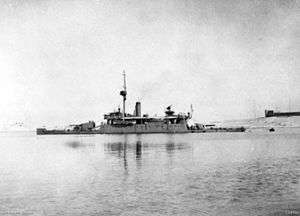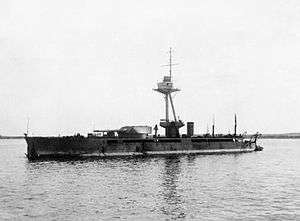List of monitors of the Royal Navy
This is a list of monitors of the Royal Navy of the United Kingdom.
Key
| Main guns | The number and type of the main battery guns |
| Displacement | Ship displacement at standard combat load |
| Propulsion | Number of shafts, type of propulsion system |
| Laid down | The date the keel began to be assembled |
| Commissioned | The date the ship was commissioned |
| Fate | The fate of the ship |
Humber-class

The Humber-class monitors were three large gunboats under construction for the Brazilian Navy in Britain in 1913, all three were taken over by the Royal Navy shortly before the outbreak of the First World War and were commissioned as small monitors, seeing extensive service during the war.
| Ship | Main guns | Displacement | Propulsion | Service | ||
|---|---|---|---|---|---|---|
| Laid down | Acquired | Fate | ||||
| HMS Humber (ex-Javary) | 2 × 6 in (15 cm) | 1,260 long tons (1,280 t) | 2 × shafts triple expansion engines 2 × boilers |
24 Aug 1912 | 8 Aug 1914 | Sold to F. Rijsdijk 17 Sep 1920 for use as a crane lighter |
| HMS Mersey (ex-Madeira) | 2 × 6 in (15 cm) | 1,260 long tons (1,280 t) | 2 × shafts triple expansion engines 2 × boilers |
24 Aug 1912 | 3 Aug 1914 | Sold for scrap 1921 |
| HMS Severn (ex-Solimoes) | 2 × 6 in (15 cm) | 1,260 long tons (1,280 t) | 2 × shafts triple expansion engines 2 × boilers |
24 Aug 1912 | 8 Aug 1914 | Sold for scrap 9 May 1921 |
Abercrombie-class

The Abercrombie-class monitors came about when Bethlehem Steel in the United States, the contracted supplier of the main armament for the Greek battleship Salamis being built in Germany, instead offered to sell the four 14"/45 caliber gun twin gun turrets to the Royal Navy on 3 November 1914, the ships were laid down and launched within six months, seeing service throughout the war.
| Ship | Main guns | Displacement | Propulsion | Service | ||
|---|---|---|---|---|---|---|
| Laid down | Commissioned | Fate | ||||
| HMS Abercrombie | 2 × 14 in (36 cm) | 6,150 long tons (6,250 t) | 2 × vertical triple expansion reciprocating engines 2 × boilers |
12 Dec 1914 | 1 May 1915 | Sold for scrap 25 Jun 1927 |
| HMS Havelock | 2 × 14 in (36 cm) | 6,150 long tons (6,250 t) | 2 × vertical triple expansion reciprocating engines 2 × boilers |
12 Dec 1914 | May 1915 | Sold for scrap 25 Jun 1921 |
| HMS Raglan | 2 × 14 in (36 cm) | 6,150 long tons (6,250 t) | 2 × vertical triple expansion reciprocating engines 2 × boilers |
1 Dec 1914 | May 1915 | Sunk 20 Jan 1918 |
| HMS Roberts | 2 × 14 in (36 cm) | 6,150 long tons (6,250 t) | 2 × vertical triple expansion reciprocating engines 2 × boilers |
17 Dec 1914 | 21 May 1915 | Sold for scrap Sep 1936 |
Lord Clive-class

The Lord Clive-class monitors, sometimes referred to as the General Wolfe-class, were built to meet the need for more shore bombardment ships, utilising twin 12-inch (305 mm) gun turrets taken from decommissioned Majestic-class pre-dreadnought battleships. Three of the ships, HMS General Wolfe, Lord Clive and Prince Eugene, were converted to take the BL 18 inch Mk I naval gun that had originally been allocated to HMS Furious.
| Ship | Main guns | Displacement | Propulsion | Service | ||
|---|---|---|---|---|---|---|
| Laid down | Acquired | Fate | ||||
| HMS Lord Clive | 2 × 12 in (30 cm) later also 1 × 18 in (46 cm) |
6,150 long tons (6,250 t) | 2 × shafts reciprocating steam engines 2 × boilers |
9 January 1915 | 10 July 1915 | Sold for scrap 10 October 1927 |
| HMS General Craufurd | 2 × 12 in (30 cm) | 6,150 long tons (6,250 t) | 2 × shafts reciprocating steam engines 2 × boilers |
9 January 1915 | 26 August 1915 | Sold for scrap 1921 |
| HMS Earl of Peterborough | 2 × 12 in (30 cm) | 6,150 long tons (6,250 t) | 2 × shafts reciprocating steam engines 2 × boilers |
16 January 1915 | 23 September 1915 | Sold for scrap 1921 |
| HMS Sir Thomas Picton | 2 × 12 in (30 cm) | 6,150 long tons (6,250 t) | 2 × shafts reciprocating steam engines 2 × boilers |
16 January 1915 | 30 September 1915 | Sold for scrap 1921 |
| HMS Sir Thomas Picton | 2 × 12 in (30 cm) | 6,150 long tons (6,250 t) | 2 × shafts reciprocating steam engines 2 × boilers |
16 January 1915 | 30 September 1915 | Sold for scrap 1921 |
| HMS Prince Eugene | 2 × 12 in (30 cm) conversion to 1 × 18 in (46 cm) incomplete at armistice |
6,150 long tons (6,250 t) | 2 × shafts reciprocating steam engines 2 × boilers |
1 February 1915 | September 1915 | Sold for scrap 1921 |
| HMS Prince Rupert | 2 × 12 in (30 cm) | 6,150 long tons (6,250 t) | 2 × shafts reciprocating steam engines 2 × boilers |
12 January 1915 | May 1915 | Sold for scrap 1923 |
| HMS Sir John Moore | 2 × 12 in (30 cm) | 6,150 long tons (6,250 t) | 2 × shafts reciprocating steam engines 2 × boilers |
13 January 1915 | May 1915 | Sold for scrap 1921 |
| HMS General Wolfe | 2 × 12 in (30 cm) later also 1 × 18 in (46 cm) |
6,150 long tons (6,250 t) | 2 × shafts reciprocating steam engines 2 × boilers |
January 1915 | 27 October 1915 | Sold for scrap 1923 |
Marshal Ney-class

The Marshal Ney-class monitors were built to utilise the two modern 15-inch turrets made available by the redesign of Renown and Repulse as battlecruisers.
| Ship | Main guns | Displacement | Propulsion | Service | ||
|---|---|---|---|---|---|---|
| Laid down | Commissioned | Fate | ||||
| HMS Marshal Soult | 2 × 15 in (38 cm) | 6,670 long tons (6,780 t) | 2 × shafts Diesel engines |
August 1918 | Sold for scrap 10 July 1946 | |
| HMS Marshal Ney | 2 × 15 in (38 cm) | 6,670 long tons (6,780 t) | 2 × shafts Diesel engines |
August 1915 | Sold for scrap 1957 | |
Gorgon-class

The Gorgon-class monitors were originally built as coastal defence ships for the Royal Norwegian Navy, but requisitioned for British use.
| Ship | Main guns | Displacement | Propulsion | Service | ||
|---|---|---|---|---|---|---|
| Laid down | Commissioned | Fate | ||||
| HMS Gorgon (ex-Nidaros) | 2 × 9.2 in (23 cm) | 5,746 long tons (5,838 t) | 2 × shafts Vertical triple-expansion steam engines 4 × boilers |
11 June 1913 | 1 May 1918 | Sold for scrap 26 August 1928 |
| HMS Glatton (ex-Bjørgvin) | 2 × 9.2 in (23 cm) | 5,746 long tons (5,838 t) | 2 × shafts Vertical triple-expansion steam engines 4 × boilers |
26 May 1913 | 31 August 1918 | Wrecked by explosion 16 September 1918 |
M15-class

The M15-class monitors were fourteen ships ordered in March 1915, as part of the War Emergency Programme of ship construction, mounting 9.2 inch Mk VI gun turrets removed from the Edgar-class and the Mk X turrets held in stock for the Drake-class and Cressy-class cruisers.
| Ship | Main guns | Displacement | Propulsion | Service | ||
|---|---|---|---|---|---|---|
| Laid down | Commissioned | Fate | ||||
| HMS M15 | 1 × 9.2 in (23 cm) | 540 long tons (550 t) | 4 × shafts 4-cylinder semi-diesel engines |
1 March 1915 | June 1915 | Sunk by UC-38 on 11 November 1917. |
| HMS M16 | 1 × 9.2 in (23 cm) | 540 long tons (550 t) | 4 × shafts 4-cylinder semi-diesel engines |
1 March 1915 | June 1915 | Sold 29 January 1920 |
| HMS M17 | 1 × 9.2 in (23 cm) | 540 long tons (550 t) | 4 × shafts 4-cylinder semi-diesel engines |
1 March 1915 | June 1915 | Sold 12 May 1920 |
| HMS M18 | 1 × 9.2 in (23 cm) | 540 long tons (550 t) | 4 × shafts 4-cylinder semi-diesel engines |
1 March 1915 | July 1915 | Sold 29 January 1920 |
| HMS M19 | 1 × 9.2 in (23 cm) | 540 long tons (550 t) | 4 × shafts 4-cylinder semi-diesel engines |
1 March 1915 | June 1915 | Sold 12 May 1920 |
| HMS M20 | 1 × 9.2 in (23 cm) | 540 long tons (550 t) | 4 × shafts 4-cylinder semi-diesel engines |
1 March 1915 | July 1915 | Sold 29 January 1920 |
| HMS M21 | 1 × 9.2 in (23 cm) later 1 × 7.5 in (19 cm) |
540 long tons (550 t) | 2 × shafts Triple Expansion steam engines |
1 March 1915 | July 1915 | Sunk 20 October 1918 off Dover |
| HMS M22 (later HMS Medea) | 1 × 9.2 in (23 cm) | 540 long tons (550 t) | 2 × shafts Triple Expansion steam engines |
1 March 1915 | August 1915 | Converted to a minelayer in 1920, renamed HMS Medea 1925, became a training ship 1937, sold 1938, wrecked 2 January 1939 |
| HMS M23 (later RNVR Claverhouse) | 1 × 9.2 in (23 cm) later 1 × 7.5 in (19 cm) |
540 long tons (550 t) | 4 × shafts 4-cylinder semi-diesel engines |
1 March 1915 | July 1915 | Became a Royal Naval Volunteer Reserve drillship, and was renamed Claverhouse in 1922, sold 1959 |
| HMS M24 | 1 × 9.2 in (23 cm) later 1 × 7.5 in (19 cm) |
540 long tons (550 t) | 4 × shafts Campbell 4-cylinder paraffin engines |
1 March 1915 | August 1915 | Sold 29 January 1920 for conversion to a mercantile oil tanker, and renamed Satoe |
| HMS M25 | 1 × 9.2 in (23 cm) later 1 × 7.5 in (19 cm) |
540 long tons (550 t) | 4 × shafts 4-cylinder semi-diesel engines |
1 March 1915 | September 1915 | Scuttled in the Dvina River 16 September 1919 |
| HMS M26 | 1 × 9.2 in (23 cm) later 1 × 7.5 in (19 cm) |
540 long tons (550 t) | 4 × shafts 4-cylinder semi-diesel engines |
1 March 1915 | October 1915 | Sold 29 January 1920 |
| HMS M27 | 1 × 9.2 in (23 cm) later 1 × 6 in (15 cm) |
540 long tons (550 t) | 4 × shafts 4-cylinder semi-diesel engines |
1 March 1915 | November 1915 | Scuttled in the Dvina River 16 September 1919 |
| HMS M28 | 1 × 9.2 in (23 cm) later 1 × 6 in (15 cm) |
540 long tons (550 t) | 4 × shafts 4-cylinder semi-diesel engines |
1 March 1915 | August 1915 | Sunk during the Battle of Imbros on 20 January 1918 |
M29-class

The M29-class monitors were five ships ordered in March 1915, as part of the War Emergency Programmeof ship construction.
| Ship | Main guns | Displacement | Propulsion | Service | ||
|---|---|---|---|---|---|---|
| Laid down | Commissioned | Fate | ||||
| HMS M29 (later HMS Medusa, HMS Talbot & HMS Medway II) | 2 × 6 in (15 cm) | 535 long tons (544 t) | 4 × shafts Triple expansion engines. Oil fuel 45 tons boilers |
1 March 1915 | June 1915 | Converted to minelayer and renames HMS Medusa in 1925, converted to a repair ship and became the depot ship and renames HMS Talbot in 1941, again renamed HMS Medway II in 1944, sold in December 1946 for breaking |
| HMS M30 | 2 × 6 in (15 cm) | 535 long tons (544 t) | 4 × shafts Triple expansion engines. Oil fuel 45 tons boilers |
1 March 1915 | July 1915 | Sunk by shore batteries at the Gulf of Smyrna 14 May 1916 |
| HMS M31 (later HMS Melpomene, then HMS Menelaus) | 2 × 6 in (15 cm) | 535 long tons (544 t) | 4 × shafts Triple expansion engines. Oil fuel 45 tons boilers |
1 March 1915 | July 1915 | Converted to minelayer in 1923, renamed HMS Melpomene in 1925, converted to a torpedo training vessel in 1939, renamed HMS Menelaus in 1941, in 1944, sold in 1948 for breaking |
| HMS M32 | 2 × 6 in (15 cm) | 535 long tons (544 t) | 4 × shafts Triple expansion engines. Oil fuel 45 tons boilers |
1 March 1915 | June 1915 | Sold on January 1920 for use as an oil tanker, and named Ampat |
| HMS M33 (later HMS Minerva and Hulk C23) | 2 × 6 in (15 cm) | 535 long tons (544 t) | 4 × shafts Triple expansion engines. Oil fuel 45 tons boilers |
1 March 1915 | June 1915 | Converted to mine-laying training ship and was renamed HMS Minerva in 1925, later became a fuelling hulk and boom defence workshop, renamed Hulk C23, currently museum ship at Portsmouth |
Erebus-class
.jpg)
The Erebus-class monitors were two ships mounting a single twin BL 15 inch Mk I naval gun turret. They saw active service in World War I off the Belgian coast, were placed in reserve between the wars then served in World War II, with Terror being lost in 1941 and Erebus surviving to be scrapped in 1946.
| Ship | Main guns | Displacement | Propulsion | Service | ||
|---|---|---|---|---|---|---|
| Laid down | Commissioned | Fate | ||||
| HMS Erebus | 2 × 15 in (38 cm) | 8,000 long tons (8,100 t) | 2 × shafts 4 x oil-fired boilers |
12 October 1915 | 2 September 1916 | Scrapped July 1946 |
| HMS Terror | 2 × 15 in (38 cm) | 8,000 long tons (8,100 t) | 2 × shafts 4 x oil-fired boilers |
26 October 1915 | 6 August 1916 | Sunk 23 February 1941 off Derna, Libya |
Roberts-class
.jpg)
The Roberts-class monitors were two ships mounting a single twin BL 15 inch Mk I naval gun turret built during the Second World War, featuring shallow draught for operating inshore, broad beam to give stability and a high observation platform to observe fall of shot.
| Ship | Main guns | Displacement | Propulsion | Service | ||
|---|---|---|---|---|---|---|
| Laid down | Commissioned | Fate | ||||
| HMS Roberts | 2 × 15 in (38 cm) | 7,970 long tons (8,100 t) | 2 × shafts 2 × Parsons steam turbiness 2 × boilers |
30 April 1940 | 27 October 1941 | Sold for scrap June 1965 |
| HMS Abercrombie | 2 × 15 in (38 cm) | 8,536 long tons (8,673 t) | 2 × shafts 2 × Parsons steam turbiness 2 × boilers |
26 April 1941 | 5 May 1943 | Scrapped 24 December 1954 |
| Wikimedia Commons has media related to Category:Monitors of the United Kingdom. |
